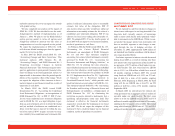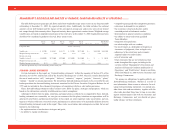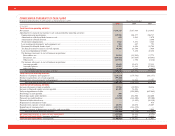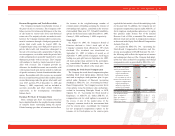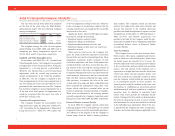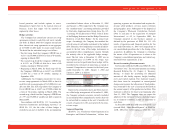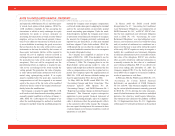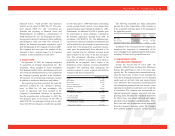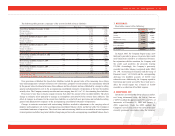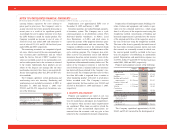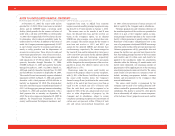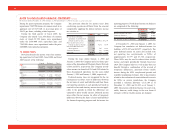Advance Auto Parts 2005 Annual Report Download - page 44
Download and view the complete annual report
Please find page 44 of the 2005 Advance Auto Parts annual report below. You can navigate through the pages in the report by either clicking on the pages listed below, or by using the keyword search tool below to find specific information within the annual report.
The fair value of each stock option was estimated
on the date of the grant using the Black-Scholes
option-pricing model with the following weighted
average assumptions:
2005 2004 2003
Risk-free interest rate ............... 3.7% 3.3% 3.1%
Expected dividend yield........... ———
Expected stock price volatility.. 33.2% 34.3% 41.0%
Expected life of stock options.. 4 years 4 years 4 years
The weighted average fair value of stock options
granted during fiscal 2005, 2004 and 2003 used in
computing pro forma compensation expense was
$10.54, $8.28 and $5.07 per share, respectively.
Goodwill and Other Intangible Assets
In accordance with SFAS No. 142, “Goodwill and
Other Intangible Assets,” the Company tests goodwill
for impairment at least on an annual basis. Testing for
impairment is a two-step process as prescribed in
SFAS No. 142. The first step is a review for potential
impairment, while the second step measures the
amount of impairment, if any. Under the guidelines
of SFAS No. 142, the Company is required to per-
form an impairment test at least on an annual basis at
any time during the fiscal year provided the test is
performed at the same time every year. The Company
has elected to complete its annual impairment test as
of the end of its third quarter. An impairment loss
would be recognized when the assets’ fair value is
below their carrying value.
Valuation of Long-Lived Assets
The Company evaluates the recoverability of its
long-lived assets under the provisions of SFAS No.
144, “Accounting for the Impairment or Disposal of
Long-Lived Assets.” SFAS No. 144 requires the
review for impairment of long-lived assets, whenever
events or changes in circumstances indicate that the
carrying amount of an asset might not be recoverable
and exceeds its fair value.
Significant factors, which would trigger an impair-
ment review, include the following:
• Significant negative industry trends;
• Significant changes in technology;
• Significant underutilization of assets; and
• Significant changes in how assets are used or are
planned to be used.
When such an event occurs, the Company esti-
mates the future cash flows expected to result from
the use of the asset and its eventual disposition. These
impairment evaluations involve estimates of asset
useful lives and future cash flows. If the undiscount-
ed expected future cash flows are less than the carry-
ing amount of the asset and the carrying amount of
the asset exceeds its fair value, an impairment loss is
recognized. Management utilizes an expected present
value technique, which uses a risk-free rate and mul-
tiple cash flow scenarios reflecting the range of pos-
sible outcomes, to estimate fair value of the asset.
Actual useful lives and cash flows could differ from
those estimated by management using these tech-
niques, which could have a material affect on our
results of operations, financial position or liquidity.
There were no reductions to the carrying amounts
currently assigned to the Company’s long-lived assets
during fiscal years 2005, 2004 and 2003, respectively.
Financed Vendor Accounts Payable
In fiscal 2004, the Company entered a short-term
financing program with a bank allowing it to extend
its payment terms on certain merchandise purchases.
The substance of the program is for the Company to
borrow money from the bank to finance purchases
from vendors. The Company records any discount
given by the vendor to the value of its inventory and
accretes this discount to the resulting short-term
payable to the bank through interest expense over the
extended term. At December 31, 2005 and January 1,
2005, $119,351 and $56,896, respectively, was
payable to the bank by the Company under this pro-
gram and is included in the accompanying condensed
consolidated balance sheets as Financed Vendor
Accounts Payable.
Lease Accounting
The Company leases certain store locations, distri-
bution centers, office space, equipment and vehicles,
some of which are with related parties. Initial terms
for facility leases are typically 10 to 15 years, fol-
lowed by additional terms containing renewal options
at five year intervals, and may include rent escalation
clauses. The total amount of the minimum rent is
expensed on a straight-line basis over the initial term
of the lease unless external economic factors exist
such that renewals are reasonably assured, in which
case the Company would include the renewal period
in its amortization period. In those instances the
renewal period would be included in the lease term
for purposes of establishing an amortization period
and determining if such lease qualified as a capital or
operating lease. In addition to minimum fixed
rentals, some leases provide for contingent facility
rentals. Contingent facility rentals are determined on
the basis of a percentage of sales in excess of stipu-
lated minimums for certain store facilities as defined
in the individual lease agreements. Most of the leas-
es provide that the Company pay taxes, maintenance,
insurance and certain other expenses applicable to the
42
NOTES TO CONSOLIDATED FINANCIAL STATEMENTS
(continued)
For the Years Ended December 31, 2005, January 1, 2005 and January 3, 2004 (in thousands, except per share data)



